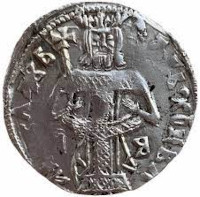Believed to be extinct, the Milesheva Moloss was a breed supposedly developed by King Vladislav of Eastern Serbia in the 1230s, inspired by the great Greek royal dogs like the Skilos tou Pyrrou and the Skilos tou Alexandrou, King Vladislav ordered to create an established breed in his name, after supposedly receiving a vision from God. Initially using only the Sarplaninac, Sumadinac and Naissus, he also introduced some Greek Sheepdogs and Central Asian Sheepdogs to create a dog with the coloration of the one in his vision. The result was a colossal breed with docked tail and cropped ears, bearing resemblance to some Central Asian Shepherd Dog types found today. Said to be "as big as a donkey, as mean as a wolf, as smart as a man and as fair as an angel", the Milesevac was a dog that inspired awe wherever it was seen. The king gave many dogs to other kingdoms, but he saved the best specimens for the priests of the Milesheva monastery. There the dogs were used as cart pullers and guards, but soon they became a nuisance for inexperienced monks to care for, due in part to the breed's aggressive nature, such as its size and power. When King Vladislav died, the dogs were given to the new King Urosh, who showed very little interest in them and subsequently gave them away to villagers to use as they saw fit.
Popular for its working skills, the breed survived among peasants until the Otoman invasion, when a large number of dogs were destroyed by the Turks for being too aggressive. While many believe that King Vladislav's Molossus never survived the centuries under Turkish rule, some are convinced that the breed was saved by the western Serbs and that the Dinara Sheepdog is its direct descendant. Regardless of the difference in size and coat type, there are some striking similarities. The great Milesheva Moloss was always richly double-fleeced and bicolored, preferably wolf-gray with large white patches. It is said that the average representative of this breed was never less than 96.5 centimetres. |







 English (United Kingdom)
English (United Kingdom)